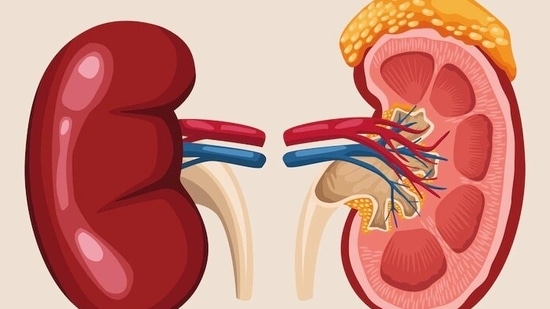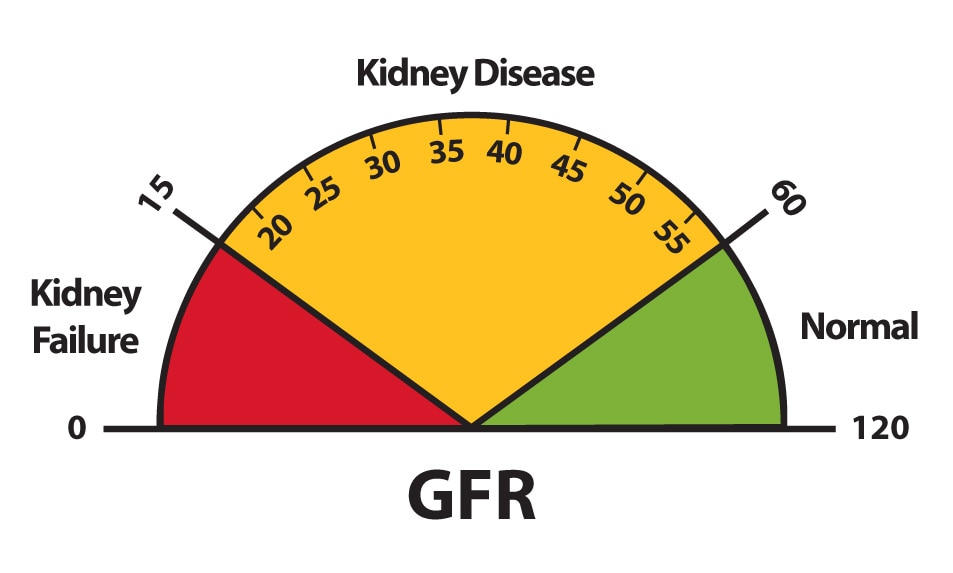10 kidney facts
Keep track of your kidney data with PKB
This article will describe 10 kidney facts.

Let’s now go through 10 top facts about the kidneys.
1. Where are the kidneys and how big are they?
The kidneys are two bean-shaped organs located on either side of the spine, just below the rib cage. They are about the size of your palm: 12 (10-14) cm long, 6 cm wide and 3 cm deep, and weigh 150g.
The right kidney is slightly lower, as it is pushed down by the liver.
Click here to read more about where the kidneys are located.
Note: Most people are born with two kidneys but 1 in 1000 people are born with one. They will have normal renal function and do not go into CKD unless a disease process happens. Click here to read more about the effects of living with one kidney.
2. Can you feel your kidneys?
No. You are not normally able to feel your kidneys. If you can, they are usually pathological (abnormal). They have to enlarge at least 2x to be palpable.
In a few slim people, a normal right kidney is palpable on a deep breath in.
3. What is the main function of the kidneys?
The main function of the kidneys is to filter waste products and excess water from the blood to produce urine.
They are key parts of the urinary tract.
4. What are the additional functions of the kidney?
The kidney has 7 functions.
Primary excretory functions (3) – functions involving the filtration of waste in the body include:
1. Fluid and electrolyte balance – e.g. removal of water, sodium, potassium and other excess salts
2. Waste removal – e.g. urea and creatinine. Note these are ‘marker molecules’ and not toxic themselves
3. Acid-base balance (including acid removal) – ensuring that blood pH remains within a normal range.
Other metabolic functions (4) – besides filtering waste, the kidneys also help regulate the body’s:
4. Red cells and haemoglobin – as they produce erythropoietin (EPO), which stimulates the production of red blood cells in the bone marrow
5. Bone biochemistry – via the activation (strengthening) of cholecalciferol (vitamin D). This helps regulate calcium, phosphate and parathyroid hormone (PTH) levels in the blood and bones
6. Blood pressure – via production of renin, which regulates blood pressure
7. Prostaglandins – complex actions, which aid your body’s immune response.
Click here to read more about the functions of the kidney.
5. How do the kidneys work?
Each kidney contains 1 million tiny filters called called glomeruli, which act as tiny sieves in the filtration process.
In other words, the entire organ is not one big filter. It is a million tiny ones.

6. What is Glomerular Filtration Rate (GFR)?
This is the amount of filtrate formed per minute by the glomeruli in the kidneys – it is a measure of kidney function because it shows us how much the kidneys are filtering and doing their job.
Normal human GFR is about 120 ml/min, or 7 litres per hour, or 180 litres per day.
Therefore the kidneys filter (and clean) your blood 36x a day, with a blood volume of 5 litres. Even though 180L are filtered, most of the filtered liquid is put back (reabsorbed) into the blood as only 2L of urine emerge each day – if you drink 2.5L a day.
This will equate to a normal blood creatinine (a waste product in your blood that comes from muscles that we use as a measure of filtration) of 60-120 micromol/L.
7. What is an Acute Kidney Injury (AKI)?
An AKI is a condition in which the kidneys rapidly lose function (usually over hours or days), potentially leading to kidney failure if left untreated.
Up to 1/3 of hospital admissions – medical and surgical – have a degree of AKI, which is usually ‘pre-renal’ (the problem is due to something else causing reduced blood flow before the blood even gets to the kidneys). The cause of pre-renal AKI is usually dehydration and sepsis (severe infection).
Click here to read more about AKI.
8. What is Chronic Kidney Disease (CKD)?
Chronic kidney disease (CKD) is a long-term condition where the kidneys do not work as well as they should, or are damaged in some other structural way.
If affects 10% of the population.
Click here to read more about CKD.
9. What are kidney infections and stones?
A kidney infection is called pyelonephritis. Most urinary tract infections (UTIs) are bladder infections (or cystitis).
Kidney stones, which are common, can form when there is an accumulation of certain substances in the urine, causing them to crystallise and form solid masses.
These masses get stuck when leaving the kidney and cause a blockage which can be very painful! Many are composed of calcium oxalate.

10. What is kidney cancer?
Kidney cancer includes cancers of the outer kidney (90%; cortex and medulla), inner kidney (5%; pelvis, drainage system) and the ureter (5%).
Most outer kidney cancers are adenocarcinomas (or renal cell carcinomas, RCCs). Most inner kidney and ureter cancers are transitional cell carcinomas (TCCs).
Summary
We have described 10 kidney facts. We hope you have found it helpful.
Last Reviewed on 20 May 2024

